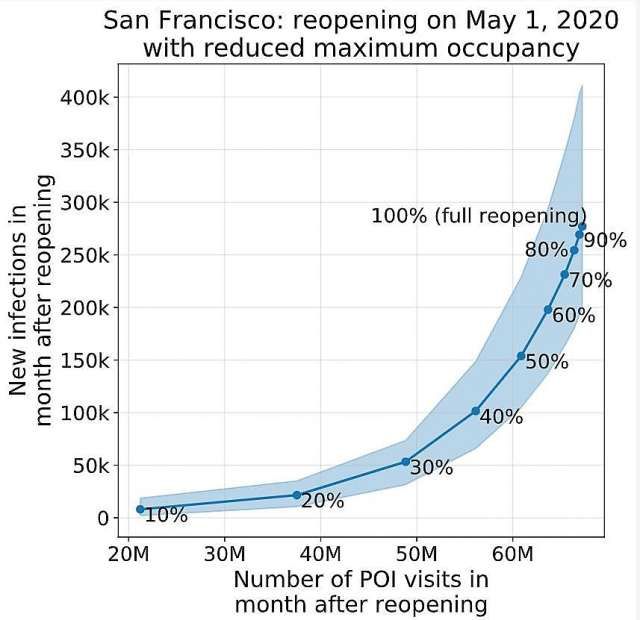A new study by a team of Stanford researchers used cellphone data to track behavior in 10 U.S. metropolitan areas between March and May, and provides convincing evidence that a large percentage of COVID-19 transmission was occurring in crowded indoor spaces including restaurants, bars, gyms, and grocery stores.
The study, published last week in the journal Nature, is titled, "Mobility network models of COVID-19 explain inequities and inform reopening." Researchers looked at population movements, via the cellphones of 98 million people in the metro areas of Atlanta, Chicago, Dallas, Houston, Los Angeles, Miami, New York, Philadelphia, San Francisco, and Washington, D.C. And they conclude that rising infection rates could be traced to particular "places of interest" (POIs) — and these were often crowded businesses in low-income neighborhoods, where interior spaces tended to be smaller and with more people per square foot. This, the researchers say, helps to explain why communities of color and low-income neighborhoods were among the first and hardest hit in the pandemic.
"Our model predicts that a small minority of 'superspreader' POIs account for a large majority of infections and that restricting maximum occupancy at each POI is more effective than uniformly reducing mobility," the researchers write. "[Also] we find that disadvantaged groups have not been able to reduce mobility as sharply [as other groups], and that the POIs they visit are more crowded and therefore higher-risk."
Community behavior was obviously not uniform across the ten metro areas studied, and masking policies were not universal in these places during the first two months of the pandemic. But the paper gives credence to public-health policies, like ones being deployed in San Francisco, that use capacity limits and the closure of certain types of businesses in order to slow the spread of the virus.
One of the researchers, Jure Leskovec, a Stanford computer scientist who works with the Chan Zuckerberg Biohub, tells the New York Times, "Restaurants were by far the riskiest places, about four times riskier than gyms and coffee shops, followed by hotels." And restaurants in low-income neighborhoods were the most risky because they tended to be the most crowded.
Similarly, grocery stores in low-income neighborhoods had 60 percent more people per square foot, and shoppers tended to stay in them for longer durations, the paper finds.
Furthermore, as the Chronicle notes, the researchers' model predicts that if businesses were permitted to reopen immediately at 100-percent capacity, the impact on the infection rate is exponential versus 10-percent or 25-percent capacity.

"The first important finding is this prediction we make, that if people were to continue to live their lives [as usual, without restrictions], one-third of the population of the 10 largest U.S. cities would be infected after one month," Leskovec tells the Chronicle.
"Reopening the economy is not an all-or-nothing type of decision," Leskovec adds. “We can reopen at different levels."
So, in the absence of universal and comprehensive contact-tracing, we now have more evidentiary fuel for the idea that particular kinds of businesses are danger zones for virus spread — and it means we'll likely be dining outdoors for months to come, until infection rates die down very significantly.
Photo: Atoms

